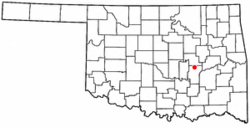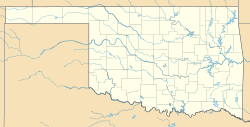Wetumka, Oklahoma facts for kids
Quick facts for kids
Wetumka
|
|
|---|---|

Location of Wetumka, Oklahoma
|
|
| Country | United States |
| State | Oklahoma |
| County | Hughes |
| Area | |
| • Total | 1.91 sq mi (4.94 km2) |
| • Land | 1.88 sq mi (4.88 km2) |
| • Water | 0.02 sq mi (0.06 km2) |
| Elevation | 764 ft (233 m) |
| Population
(2020)
|
|
| • Total | 1,135 |
| • Density | 602.44/sq mi (232.55/km2) |
| Time zone | UTC-6 (Central (CST)) |
| • Summer (DST) | UTC-5 (CDT) |
| ZIP code |
74883
|
| Area codes | 405 and 572 |
| FIPS code | 40-80500 |
| GNIS feature ID | 2412245 |
Wetumka is a city in Oklahoma, United States. It is located in northern Hughes County. In 2020, about 1,135 people lived there. The Muscogee Creek people first settled this area in the 1830s. They named it after their original town of Wetumpka in Alabama. The word Wetumka means "rumbling waters" in the Muskogee language.
Today, Wetumka is important as the headquarters for two Native American tribes. These are the Alabama-Quassarte Tribal Town and the Kialegee Tribal Town. The city also hosts a fun event called Sucker Day every year. It takes place on the last Saturday in September.
Contents
History of Wetumka
Early Growth and Railroad Connection
The St. Louis, Oklahoma and Southern Railway built a train line through Wetumka between 1900 and 1901. This helped Wetumka become a major shipping center. Farmers in the area sent their cotton, corn, pecans, and livestock from Wetumka. In 1908, the town tried to become the permanent county seat, which is the main town for government in a county. While Wetumka made it to a final vote, Holdenville was chosen instead.
By 1909, Wetumka had many businesses. These included three banks, places to process cotton, and shops for blacksmiths. A two-story building was built in 1912. It served as both the city hall and a meeting place for the Masonic Lodge.
Population Boom and Oil Discovery
Wetumka continued to grow. By 1918, more businesses opened, such as cotton gins, a mill, and companies providing ice, water, and light. The population grew a lot, from 231 people in 1910 to 1,422 in 1920. This growth continued until 1950. After that, the population slowly decreased as farming needed fewer workers.
In 1919, the Wetumka oil field opened. Many oil workers came to town, which made the city very busy. The railroad even built a large freight warehouse in 1925. A three-story hotel also opened that year. With the economy booming, the city paved its streets and added more rooms to the school.
Becoming a "First Class" City
A big step for Wetumka was when its citizens asked the Governor to make it a "first class" city. This meant it would have more self-governance. Governor Jack C. Walton agreed on May 21, 1923. The city then held an election in June 1925 to choose a mayor, city marshal, and council members.
By 1930, oil and farming were the main jobs in Wetumka. There were five cotton gins and twelve oil companies. The city also had nine churches, a park, a lake, and a junior college. A company called Railey Manufacturing made wood flooring and doors. The city provided water and electricity, and phone service was available. However, cotton farming started to decline in the 1930s.
Later Developments
During World War II, the U.S. Army ran a prisoner-of-war camp for German soldiers near Wetumka. This camp closed in 1945 after the war ended. The city opened its own hospital, Wetumka General Hospital, in 1960. A new city complex opened in 1973 after the old city hall was destroyed by fire in 1971. By the 1970s, all the cotton gins had closed down.
Geography of Wetumka
Wetumka is located about 15 miles (24 km) northeast of Holdenville. Holdenville is the county seat for Hughes County.
The city covers a total area of about 1.9 square miles (4.9 square kilometers). Most of this area is land, and a small part, about 20%, is water.
Population and People
| Historical population | |||
|---|---|---|---|
| Census | Pop. | %± | |
| 1910 | 231 | — | |
| 1920 | 1,422 | 515.6% | |
| 1930 | 2,153 | 51.4% | |
| 1940 | 2,340 | 8.7% | |
| 1950 | 2,025 | −13.5% | |
| 1960 | 1,798 | −11.2% | |
| 1970 | 1,687 | −6.2% | |
| 1980 | 1,725 | 2.3% | |
| 1990 | 1,427 | −17.3% | |
| 2000 | 1,451 | 1.7% | |
| 2010 | 1,282 | −11.6% | |
| 2020 | 1,135 | −11.5% | |
| U.S. Decennial Census | |||
In 2000, there were 1,451 people living in Wetumka. The population density was about 761 people per square mile (294 people per square kilometer). About 26.1% of households had children under 18. The average household had 2.31 people.
The population was spread out by age. About 26.9% were under 18, and 18.8% were 65 or older. The average age was 39 years old.
Education in Wetumka
Wetumka is part of the Wetumka Public Schools district.
The first school in Wetumka was the Levering Manual Labor Mission School. It opened on September 1, 1881. This school was run by a Baptist mission and helped educate Creek children. By 1902, Wetumka had its own public school system. The Wes Watkins Technology Center is also located in Wetumka. It opened in 1992 and offers special training for different jobs.
Fun Activities and Lakes
Wetumka has a unique annual event called Sucker Day. It started because the town was tricked by a man named F. Bam Morrison in 1950. Now, the town celebrates this story with a festival. Sucker Day includes arts and crafts, music, and a parade of old cars, tractors, and horses. There is also a "poker run" for motorcyclists and others.
North of town, you can find Wetumka Lake, also known as Lake Wetumka. It has boat ramps, a fishing dock, picnic areas, and a playground. You can also camp there. Brooks Lake is another lake located southeast of Wetumka.
Transportation Around Wetumka
The city is located where two major roads meet: U.S. Route 75 and Oklahoma State Highway 9.
Wetumka also has a small, privately-owned airport called Petes Airpark. Several other larger airports, like Okmulgee Regional and McAlester Regional, are within about 35 miles (56 km) of the city.
Notable Person from Wetumka
- John Herrington, a famous astronaut, is from Wetumka.
See also
 In Spanish: Wetumka (Oklahoma) para niños
In Spanish: Wetumka (Oklahoma) para niños


